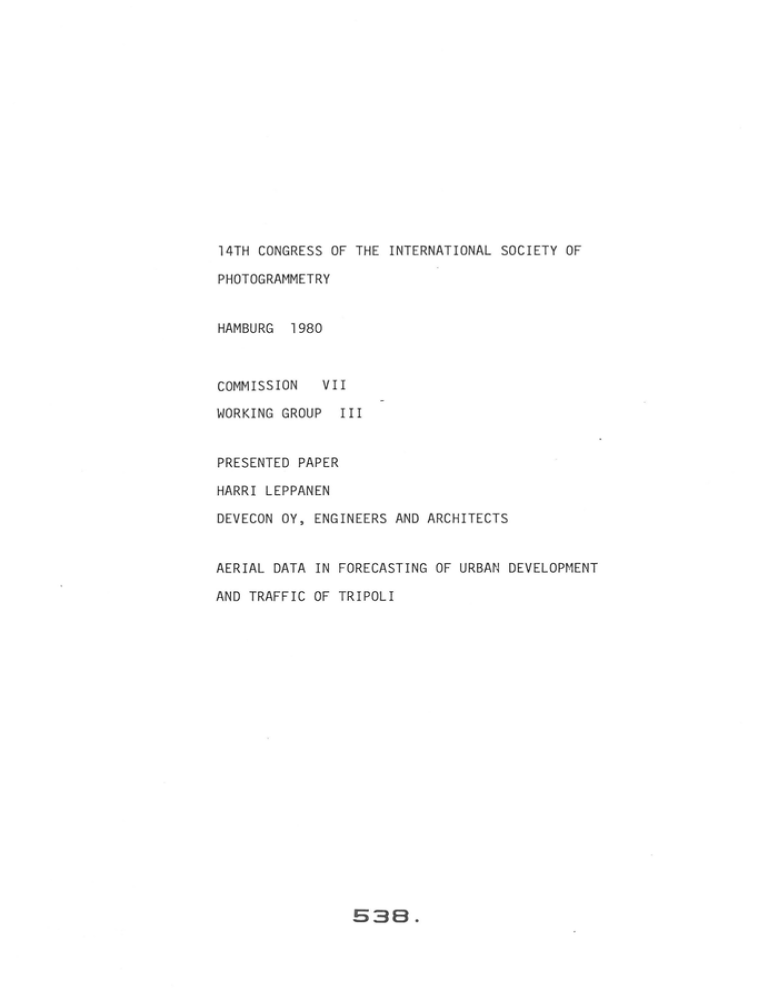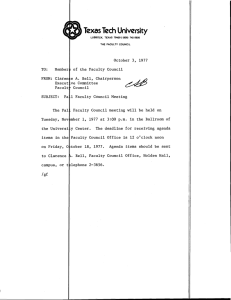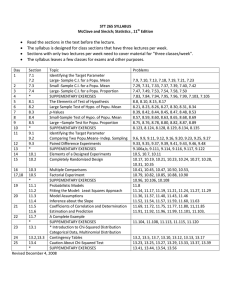14TH THE INTERNATIONAL PHOTOGRAMMETRY 1980
advertisement

14TH CONGRESS OF THE INTERNATIONAL SOCIETY OF
PHOTOGRAMMETRY
HAMBURG 1980
COMMISSION
VII
WORKING GROUP
III
PRESENTED PAPER
HARRI LEPPANEN
DEVECON OY, ENGINEERS AND ARCHITECTS
AERIAL DATA IN FORECASTING OF URBAN DEVELOPMENT
AND TRAFFIC OF TRIPOLI
538.
AERIAL DATA IN FORECASTING OF URBAN DEVELOPMENT AND TRAFFIC
OF
TRIPOLI
Introduction
In this paper one example of the use of aerial photos in
practical urban planning will be discussed . Devecon Oy
was engaged in preparing the Transportation Master Plan
of Tripoli in the Socialist People'·s Libyan Arab Jamafliriya
1977. The project includtng comprehensive traffic surveys,
forecasts and 25, 15 and 5 year trafftc plans was completed
in 1.5 years.
When studying the data material ava ila ble for planning, many
gaps were found . Almost the only comprenensive and reliable
source of information was the populati.on cen-sus carried out
in 1973, in which populati on by mahallan (s-tatical zone),
househo l d size, sex, age distribution and economically active
population were surveyed. Especially statistics of economic
activiti es and employments were insufficient, again the census
material gave the most reliable figures . Statisics about
housing existed but they were very general.
Maps and aerial photos were quite good: black and white aerial
photography 1:25 000 from 1973 and l : 5000 topographical maps
comp il ed from this photography as well as l :20 000 black and
white photography from December 1976 were available.
The city pl ans were out of date. The most recent master plan
was from 1966 - 69 and since that the situation and trends of
deve l opment in Tripoli have been throughly changed, due to among
other things a revolution, which took place in 1969. However,
the sectoral master plans, among them the Transportation Master
Plan, were based upon this master plan .
539.
It was found quite necessary to create new stat i stical
background for pl anning . In this respect a l and and space
use survey (l) of the entire ci ty was carri ed out. Th i s
survey was in many ways used in the planning and forecasting
processes . The methods and the results of this use are
di scussed be l ow .
Land and space use survey
The l and and space use survey was carri ed out to form the
bas i c new information source for the work. Fol l owin g i nformat i on could be obtained from survey results allocated by
city zone :
- total land area of the city and the zones
- distribution of land use by economi c activity
ground floor space, i.e area covered by bui l dings cl assif i ed
by l and use activity .
- tota l f l oor space by economic activity .
Thus in addition to l and use the intensity of it was also
measured i n terms of ground f l oor space and total floor space .
The survey method and procedure has been presented i n previous
publ i cat i ons (l) Stereocopic aeria l photo interpretation was
of gr eat i mportance and the essenti al method in practical survey .
DEFINITION OF ACTUAL POPULATION 1977
Because of the fast urban development i n Tri pol i s i nce 1973,
the populat i on f i gures of the 1977 census were not accurate
enough to be used in the traffic mode l ca l ibration based on
surveys carried out in Ju ly 1977. Special l y the distr i bution
of the popu l ation by ci ty zone, one of the key factors in
traffic modelling, had to be revised.
The actua l population by city zone was processed out as fo ll ows :
1- The res i dentia l f l oor space fo r each mahallah (l mahallah= l- 3
540.
city zones used i n the traffic and land use survey) were
calculated from the land use and space use survey results .
2- A development ratio indicating difference between 1973 and
1977 residential floor space was determined for each city
zone and further for each mahallah. This was done by
compar i ng the 1973 and 1977 aerial photographies zone by zone .
Excluding areas of exceptional changes i.e. new residential
areas or demolished s l um areas, in which the new or the
demolished residential floor spaces should be determi ned
accurately as i n the 1977 land and space use survey, it was
found accurate enough to compare residential ground f l oor
spaces for both years .
3- Using development ratios the 1973 residential f l oor spaces
for each city zone and maha ll ah were calcu l ated .
4- Knowing the 1973 populat i on by maha ll ah from the census 1973
popu l ation by ci ty zone was ca l cu l ated by di stributing the
popu l ation of mahallahs to the city zones proportional l y to
the reside~tial f l oor space in each zone .
5- Fina l ly the popu l ation of 1977 by ci ty zone was extrapolated
using the above mentioned development ratios ( i. e. the 1977
residential floor space versus the 1973 residential floo r
space) assuming that the average urban density (inhab i tants/
res i dential floor space) in each zone had remained unchanged.
Th i s assumption was found justi fied in comparision of the
situations with aerial photos . The changes in the res i dental
f l oorspace between those years were l ess than 20 ~ of the total
in each zone .
6- The tota l popu l ation 1977 for the ent ire city was ca l cul ated
and compared with an est i mate made us i ng average growth rate
1973 - 1977 . Th i s rate cou ld be estimated from annua l r eg i stra t i on of Li byan populat i on in some pa rt s of the ci ty . The growth
and di str ibu ti on of expatr i ate pop ul at i on , howeve r, wa s un certa in·
541.
This check indi cated that the estimate of total popu lat ion
1977 i n Tr i pol i was accura t e enough for further use.
Specially the zonal distributi'on ef population obtained in
thi s way could be constdered re h able .
The total pop ul at i on
of Tri'pol i', whi ch was 555 000 i'n 1973 , had i'n creased to
632 000 in the beginn in g of 1977
representi~g
a 3% r ate of
annua l growth .
DEFI'NITION OF H1PLOYI'1ENT 1977
As mentioned the employment
statt~ti:cs
were i_nsufficient.
Jn 1973 census the number of econom i cally act t ve popu l ati.on
by activity was- s-urveyed and ustng th t s acti.vity rate an
esti_mate of numBer of jobs· i'n ead1 category of economi c
act i. vities cou l d be made.
However , th'e zonal distribution
CJf jobs was· unknown. because tile
worki~g
popul at i'on was
al l ocated in accordance wit n the tr residences, not wi th
the location of their jobs.
The number of jobs by act ivi ty and thetr zona l di'str i but t on
was est imate.d fo ll owin gl y:
1- Us i'n g the above estimated tota l
populati~n
1977 and the
aver age activity rate e>btained from the household i:nterview
s·urvey the tot a 1 number of
esti:mated .
jobs in the enti re c t ty was
lt was found that tfie activ i'ty rate 1977
was s.l i'ghtly hi'gher than th.e corr espondi'n g rate 1973.
2~
Th t s number was adjusted tn accordance wtth home based
work t rtp s- commuting tn and out of Ute cHy . whtch were
obs-erved
;~
a roadstde
i~t ervi:ew
survey at the outer
go r don li_ ne 1ocated at the city bo rd er .
3- The di stri_buti'on of jobs by acti:vi:ty was.· determ i:ned ust:ng
res-ults of tne 1973 census and 'Various: stat i s·ti'ca 1 s·our ces
(other stud i.es about the same s-ubject J.
542 .
4- The zonal distribution of jobs by activity was estimated
using zonal distribution of floor soace by activity
(excluding residential floor space) obtained from space
use survey .
The estimate gave the fo 11 owi.ng results
- number of jobs in accordance wi~h activtty rate(25.4%)160000
- number of jobs in accordance wi'th the esttmated
net cof11Tlunuttng
20000
- total number of jobs
180000
Thus the total number of jobs in various· economic activities
was distributed to the city zones in accordance with the
floor space occupied by the corresponding activity in each
zone . This implies that the average floor space per job
would be the same in each cateaorv all over the city .
This deduction can of course be disputed
FORECASTING OF POPULATION 2005
The forecasting procedure is always a complex issue of
assumptions, development policies and strategies. These
things are not discussed in this paper. In regard to
birth and mortality rates the growth of Tripoli is very
high and could lead to various scenarios for the future .
However, there is a considerable restricting factor availability of urban space-which affects the development
of physical conditions .
In genera l it was found desirable to preserve the existing,
still human, urban scale of the city . In this respect the
space use characteristics obtained from the space use
survey were of great importance, to describe the present
situat i on . On the other hand the development of economic
activities and the investments already made, decided or
planned (harbour, rail and street networks, park i ng, office
complex, hotels etc . ) indicated pressure to increased
Sl:l3.
efficiency in space use and consequently changes i.n the
urban sca l e .
When summarizing all these factors it was found out that
the l and reserve availab l e in the city would be used for
urban economi c act i vities and commun i cations and the
l and available for residental development would be equa l
to present residental land. Thus an in creased population
co uld only be accomodated by increasing urban densities
within the city limits.
Therefore the final forecasting process used in the Master
Plan Study cou ld be def ined as fo ll ows :
1- The natural popu l at i on growth taking i mmigrat i on in to
~::acc6unt3wa s~ ~sttm~ted .
2- An allowab l e maximum urban dens i ty
each city zone was figured out .
(i nh ab it a n t~{haj)
for
In this consideration the existing urban densities
obtained from the l and and space use su r vey were
essentia l as well as knowledge about Libyan li ving
habits and socia l structure .
It i s impossible to accurate ly define acceptab l e
env ironmenta l quality in terms of urban density on l y.
Compari sons with in ternationa l averages and especial l y
with monitored urban densities in Tripoli provided
background for this judgement .
3- Using these dens iti es a future population estimate for
each zone was made .
4- The populati on exceed in g the total obta ined from these
estimates was recommended to be channel l ed to other
sett l emen t s within the urban agglomerati on of Tripoli
and its env irons .
The fo ll owing figures will give an idea of urb an
popu l a ti ~n of Tri po li:
- urban dens i t i es
(inhab itan t s /ha)
1977
-
maximum
average
average/res idental
total population
343
54
121
632000
2005
202
71
164
822000
The urban popu l at i on is thus estimated to be more even l y
distr i buted in the future, although the average densities
are considerab ly higher.
FORECASTING OF EMPLOYMENT 2005
The basic concern from the strateg i c po int of vi ew in
forecasting empl oyment for the year 2005 was the future
economi c structure of Tripoli and the whole Jamah i r i ya .
From the env i ronmenta l po int of view, however, the
ex i st ing distribution of economic act ivi_t i es indi cated
by the number of jobs in each activity would give a good
basis for f uture development.
The work process in forecasting emp l oyment for the year
2005 was in pri nci pl e si mi l ar to the forecasting of
popu l at i on , i.e the env ironmen ta l capacity of each zone
to accomodate new activ i t i es was deducted by utilization
of the l and use and space use data and the new distribution
made in accordance with these potent ia l s tak ing al so the
population ca t chment of eacl , area tn to account .
545.
The fo ll owi ng set -u p would indicate the development
Tripoli :
1977
~n
2005
0/
:o
Of
act i vity
jobs
-
6000 3 . 3
13000 7. 2
30000 16. 7
3000 1. 7
5000
24000
20000
5000
1. 9
9.3
7. 8
1.9
3900 21. 7
15000 8 . 3
42000
28000
16. 3
10 .8
17000
9.4
41000
16.0
57000 31. 7
92000
35 . 9
agriculture
industry
constr ucti on
electri city , gas ,water
wholesale,retail trade
restaurant,hotel
- transport,communication
- financ in g,in surance , rea l
estate , serv i ces
- community,social and
personel ser vices
job5
total
180 000
257 000
employees li ving in Tripo li
avarage activ ity rate
160 000
25 . 4 %
277 000
33 . 6 ~s
,0
TRAFFIC MODEL CALIBRATION
The normal procedure of traffic model ca lib rat i on i s to
determine tri p gene rati on and attracti on in each trip
category as a fu nct io n of the land use presented in terms
of population and emp l oyment by means of mu lt i var i able
ana l ys i s . Then the f orecasted present traffic assigned
to the pr esent street network will be compared to the
act ual traffic volume and distribution monitored in
traffic surveys . The differences would indicate the
accu ra cy of the cal ibrat i on and severa l iterat i ons may
be r eq uired to adjust the discrepa ncies .
546.
In the Tripoli Study the stat i st i cs of popu l ation and
employment both for the present and for the future were
created on the basis of the land use and space use data
as described above. Thus this survey was a fundamental
importance, in wh i ch on ly an i ntensive use of aeria l
photos made an economic and work sav in g approach possible .
C0~1~1ENTS
The use of the above described methodology as well as the
land use space use survey was made in practical consulting
work, in which scientific accuracy and qua li ty tests are
impossible . However, the consu l tant is confident that the
results re li ably represent re l evant features of city
functions. It should be remembered that in a rapid l y
develop ing country many factors of the future are
uncertai n and therefore the tools of planning shou ld be
chosen corresponding ly . The present use of urban space
and the development potentia l s of urban environment will
remain as key factors for every strategic alternat ive .
Therefore these kind of stud i es will not be waste work
although with t i me and money they can be made more
comprehensive ly, more accurate l y and sc i entifi cly
more el egant.
BIBLIOGRAPHY
l) Harri leppanen:Aerial Photos in Urban Survey of Tripoli,
Proceedings of the Internationa l Symposium on Remote
Sens in g for Observation and Inventory of Earth Resources
and the Endangered Envi ronment ,
Volume II, p 1003 ,
Ju l y 2- 8, .1978, Freiburg, Federal Republic of Germany .
2) Devecon Oy : Transportation Master of Tripo li, Second Stage
Final Report 15.11. 1978, 25 Year Traffic Pl an , Project
Report for the Municipality of Tri po li.
S£J:7.



